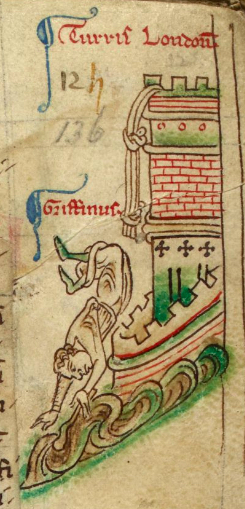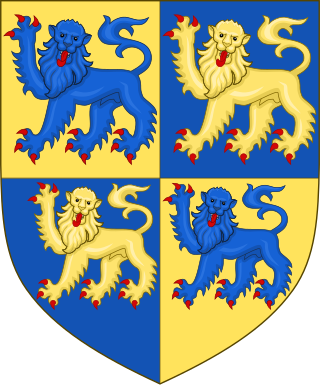Contents
| Other decades |
| 1220s | 1230s | 1240s | 1250s | 1260s |
Events from the 1240s in England .
| Other decades |
| 1220s | 1230s | 1240s | 1250s | 1260s |
Events from the 1240s in England .

Llywelyn ap Gruffudd, Llywelyn II, also known as Llywelyn the Last, was the prince of Gwynedd, and later was recognised as the prince of Wales from 1258 until his death at Cilmeri in 1282. Llywelyn was the son of Gruffydd ap Llywelyn Fawr and grandson of Llywelyn the Great, and he was one of the last native and independent princes of Wales before its conquest by Edward I of England and English rule in Wales that followed, until Owain Glyndŵr held the title during the Welsh Revolt of 1400–1415.
Llywelyn ab Iorwerth, also known as Llywelyn the Great, was a medieval Welsh ruler. He succeeded his uncle, Dafydd ab Owain Gwynedd, as King of Gwynedd in 1195. By a combination of war and diplomacy he dominated Wales for 45 years.

The Kingdom of Gwynedd was a Welsh kingdom and a Roman Empire successor state that emerged in sub-Roman Britain in the 5th century during the Anglo-Saxon settlement of Britain.

John I, known as John the Red due to the colour of his beard, was Duke of Brittany from 1221 to his death and 2nd Earl of Richmond in 1268.
This article presents a timeline of events in British history from 1000 AD until 1499 AD.
Owain ap Gruffudd was brother to Llywelyn ap Gruffudd and Dafydd ap Gruffudd and, for a brief period in the late 1240s and early 1250s, ruler of part of the Kingdom of Gwynedd.

Gruffudd ap Llywelyn ap Iorwerth was the Welsh first-born son of Llywelyn the Great. His mother Tangwystl probably died in childbirth.
Rhodri ap Gruffudd was the third or fourth son of Gruffydd ap Llywelyn Fawr. He was the younger brother of both Llywelyn ap Gruffudd of Gwynedd, Prince of Wales) and of Owain Goch ap Gruffydd. He was probably the younger brother of Dafydd ap Gruffydd of Gwynedd but may have been the older as there are no accurate records of their birth dates.
Perfeddwlad or Y Berfeddwlad was an historic name for the territories in Wales lying between the River Conwy and the River Dee. comprising the cantrefi of Rhos, Rhufoniog, Dyffryn Clwyd and Tegeingl. Perfeddwlad thus was also known as the Four Cantrefs.
This article is about the particular significance of the century 1201–1300 to Wales and its people.

Wales in the High Middle Ages covers the 11th to 13th centuries in Welsh history. Beginning shortly before the Norman invasion of the 1060s and ending with the Conquest of Wales by Edward I between 1278 and 1283, it was a period of significant political, cultural and social change for the country.

The history of Gwynedd in the High Middle Ages is a period in the History of Wales spanning the 11th through the 13th centuries. Gwynedd, located in the north of Wales, eventually became the most dominant of Welsh polities during this period. Contact with continental courts allowed for Gwynedd to transition from a petty kingdom into an increasingly sophisticated principality of seasoned courtiers capable of high level deplomacy and representation; not only with the Angevine kings, but also the king of France and the Papal See. Distinctive achievements in Gwynedd include further development of Medieval Welsh literature, particularly poets known as the Beirdd y Tywysogion associated with the court of Gwynedd; the reformation of bardic schools; and the continued development of Cyfraith Hywel. All three of these further contributed to the development of a Welsh national identity in the face of Anglo-Norman encroachment of Wales.

Eva Marshal (1203–1246) was an Anglo-Norman noblewoman, daughter of William Marshal and Isabel de Clare, the Earl and Countess of Pembroke. She married William de Braose, a marcher lord.
The Battle of Bryn Derwin was fought in Eifionydd, Gwynedd on June 1255, between Llywelyn ap Gruffudd and his brothers, Dafydd ap Gruffudd and Owain Goch ap Gruffydd.
Dafydd ap Llywelyn was Prince of Gwynedd from 1240 to 1246.

Dafydd ap Gruffydd, was Prince of Wales from 11 December 1282 until his execution on 3 October 1283 on the orders of King Edward I of England. He was the last native Prince of Wales before the conquest of Wales by Edward I in 1283 and English rule in Wales that followed, until Owain Glyndŵr held the title during the Welsh Revolt of 1400–1415.
Senana ferch Caradog (c.1198–1263) was the wife of Gruffudd ap Llywelyn Fawr (1198–1244). Senana's full name was Senana ferch Caradog ap Thomas ap Rhodri ab Owain Gwynedd therefore Owain Gwynedd was her great great grandfather, although she came from an illegitimate line. She had four sons: Owain, Llywelyn, Dafydd and Rhodri. Additionally she had two known daughters: Gwladus and Margaret. Although it is unknown exactly when she died, she was buried in 1263 in Llanfaes.
Events from the 1240s in the Kingdom of Scotland.